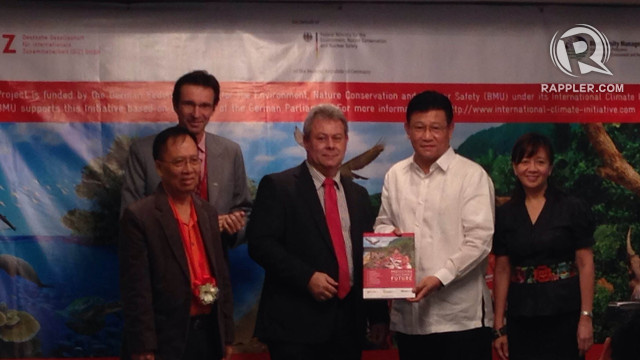SUMMARY
This is AI generated summarization, which may have errors. For context, always refer to the full article.

MANILA, Philippines – The management of protected areas in the Philippines was given a rating of “Poor” to “Fair” in a study commissioned by the Department of Environment and Natural Resources (DENR) and German government.
Released on Wednesday, January 15, the study assessed how protected areas like the famous Mt Pulag in the Cordillera and the Batanes Islands are managed by the national and local governments.
Undertaken from March to August 2013, the study used an internationally-recognized framework for rating the effectiveness of current policies and practices in keeping our natural parks intact.
The Management Effectiveness Tracking Tool (METT) is an assessment tool developed by the World Commission on Protected Areas.
It is a special type of survey answered by individuals directly involved in the management of the protected area such as park superintendents, local government officials, forest rangers and community members. The survey was also answered by experts like environment officials, biodiversity scientists, and members of the academe.
Together, the two sets of answers provide a picture of how the natural parks are overseen.
The study, entitled the “National Management Effectiveness and Capacity Assessment” (NMECA) evaluated 61 protected areas or 25% of the 240 PAs in the country.
According to Dr Ernesto Guiang, one of the authors of the report, those PAs were chosen because they are the natural parks which have the least funding from donors. Thus, findings from these PAs would give a worst-case-scenario assessment allowing the government to see where the gaps are widest.
The NMECA team also made sure to assess at least one PA from each region.
Major problems
The report gave an overall average score of 58% for the assessed PAs which corresponds to a “poor” to “fair” rating.
Major problems in the management of protected areas are to blame for the low grade:
1. Lack of funding and personnel
The report showed that on average, for every 2,300 hectares of protected area, only one person is paid to oversee conservation and management. The 59,000 hectares of the legendary Mt Apo is overseen by only 8 people. (READ: The trashing of Mount Apo)
This extreme understaffing is due to a lack of funding. The government spends only P39 per hectare to conserve a protected area, added the study.
Poor funding and lack of personnel to serve as forest rangers and park superintendents lead to poor maintenance and conservation of our natural parks.
2. Lack of legislation to boost protection
One reason why protected areas receive such poor funding is the lack of proper legislation identifying them as priority recipients of support.
The report found that only 8 PAs are covered by Republic Acts. This allows them to enjoy permanent staffing, funding and recognition that will attract more investments and donors. 57 or 93% of the assessed PAs are legitimized only by Presidential Proclamations which can easily be amended.
3. Conflicting, overlapping policies
So many policies have been made by different groups to govern management of natural parks. Guidelines from the DENR and policies covering ancestral domain overlap when part of a protected area is also part of an ancestral domain.
Local government units with jurisdiction over the PA also have policies of their own. This makes establishing accountability difficult.
Zoning laws, boundary conflicts, and clashing land and resource uses add to the confusion. In short, too many cooks spoil the broth.
4. Limited involvement of LGUs
Some LGUs don’t even include the protected area in their community’s Comprehensive Land Use Plans. This means that the LGU is unable to channel funds into the natural parks even if they have a huge impact on the communities.
If sustainably managed, these parks provide fresh water and natural resources which communities can benefit from.
Around 85% of water feeding irrigation systems nationwide come from natural habitats that act as water sheds (areas where water gathers). Protected areas make excellent water sheds.
5. Outdated management plans
Though most of the assessed PAs have management plans, these are outdated and not based on the current condition of the resources in the park. Thus, the plans lack the right conservation and protection strategies.
6. Untapped ecotourism potential
Very few of the sites reported ecotourism activities contributing to the local economy. Not many communities harness the wealth of the parks to generate more income in the form of goods from the natural parks or livelihoods tied to the park. These include serving as eco tour guides, porters or bantay dagat (sea guards). Because of this lack of investment, the communities are not motivated to protect the park.
7. Lack of expertise in park management
Officials in the local Protected Areas Management Board, park superintendents, LGU staff and community leaders lack the necessary training to effectively manage their parks.

‘Megadiverse’
The report was funded by the German federal government through Deutsche Gesellschaft für Internationale Zusammenarbeit (GIZ). GIZ leaders formally handed over the report to the DENR.
After accepting the study, Biodiversity Management Bureau Director Theresa Mundita Lim said that her agency will “see to it that the results will translate to more meaningful actions on the ground and help enhance protected area management in the country.”
The Philippines is one of the biologically richest countries in the world. It is one of 17 countries regarded as “megadiverse” because of its astounding array of flora and fauna.
But it is also identified as a “hotspot” or a country which has lost more than 70% of its original natural habitat. – Rappler.com
Add a comment
How does this make you feel?
There are no comments yet. Add your comment to start the conversation.